Sebaceous Cyst Definition and Types
For decades, 3 types of skin cysts were considered sebaceous cysts:
Later, it has been found that epidermoid and pilar cysts do not arise from the sebaceous glands, so they are actually not sebaceous cysts, so today only steatocystoma is considered a true sebaceous cyst.
The term sebaceous cyst is still widely used among people to describe all 3 types of cysts, so the main characteristics of all of them are described in this article. For details about each type of cyst, check the separate articles.
Common Symptoms
Common symptoms of epidermoid and pilar cyst and steatocystoma:
- They appear as dome-shaped bumps or lumps, from few millimeters to several centimeters in size and can be single or multiple.
- They are firm, movable, with smooth surfaces, covered by a normal, white or yellow skin, usually painless but can be itchy [2,3].
- Some of them have a small opening at the top through which you can squeeze a greasy material [5,6].
- They can have rancid smell [6].
- When inflamed, they are usually tender, painful and covered by a red skin [3].
- They can be found mainly in middle-aged adults and only rarely in children [2,6].
- They grow slowly, so they tend to increase in size over the months or years, but they can heal on their own.
Locations
Pilar cysts appear mainly on the scalp, while epidermoid cysts and steatocystomas appear mainly on the face, behind the ears, on the neck, chest, back, shoulders or upper arms and less commonly on the female (vagina, labia) or male genitalia (scrotum, penis), perineum, groin, breast, armpit or wrist [4,6].
Sebaceous cysts do not appear on the palms or soles.
Forehead

Picture 1. A) A small epidermal cyst on the front of the head. B) After cyst removal
(source: Archives of Plastic Surgery, CC license)
Neck
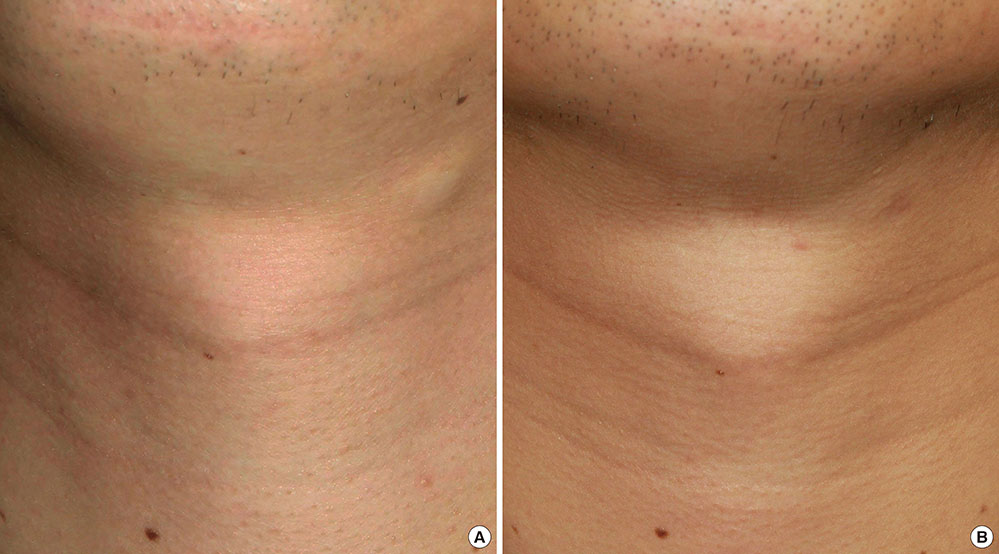
Picture 2. A) A small epidermal cyst on the right front side of the neck
B) A small scar after the cyst removal
(source: Archives of Plastic Surgery, CC license)
Scalp |
Ear |
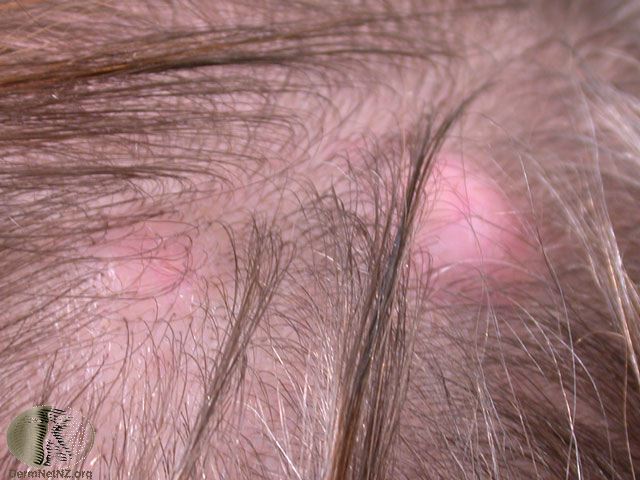 |
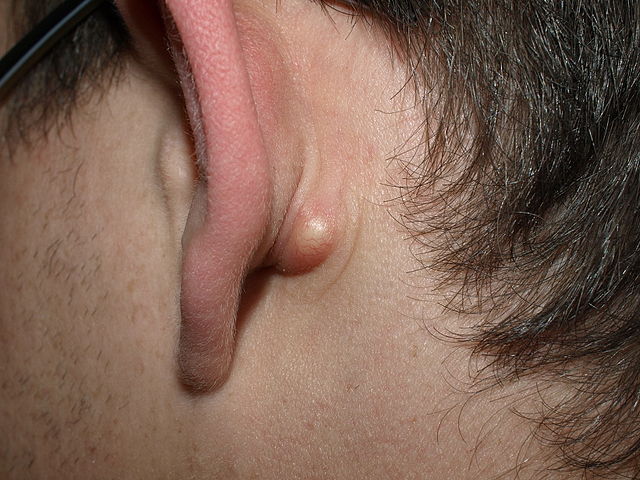 |
| Picture 3. Two sebaceous (pilar) cysts on the scalp (source: DermNetNZ, CC license) | Picture 4. A sebaceous cyst behind the ear (source: Klaus D. Peter, Wikimedia, CC license) |
Face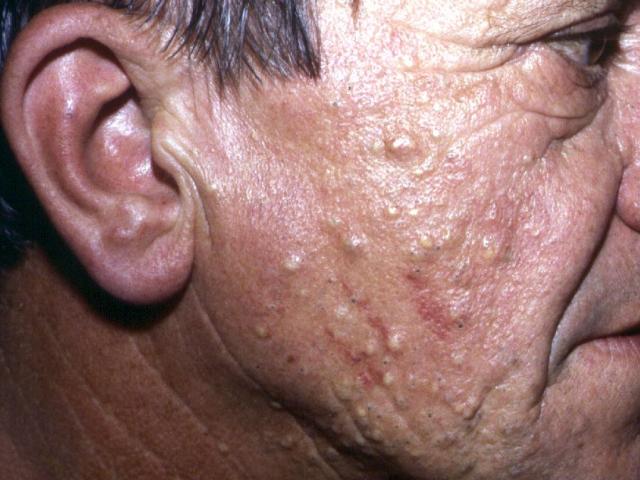
Picture 5. True sebaceous cyst (steatocystoma multiplex)
on the face (source: Dermatology Atlas)
Causes and Risk Factors
- Being past puberty
- History of acne
- Skin injury, piercing or surgical wound
- Swollen hair follicles
- High levels of the hormone testosterone
- Use of androgenic anabolic steroids
- Familial colorectal polyposis or Gardner’s syndrome [11]
- Reference: [4,10]
Complications
Inflammation and Infection
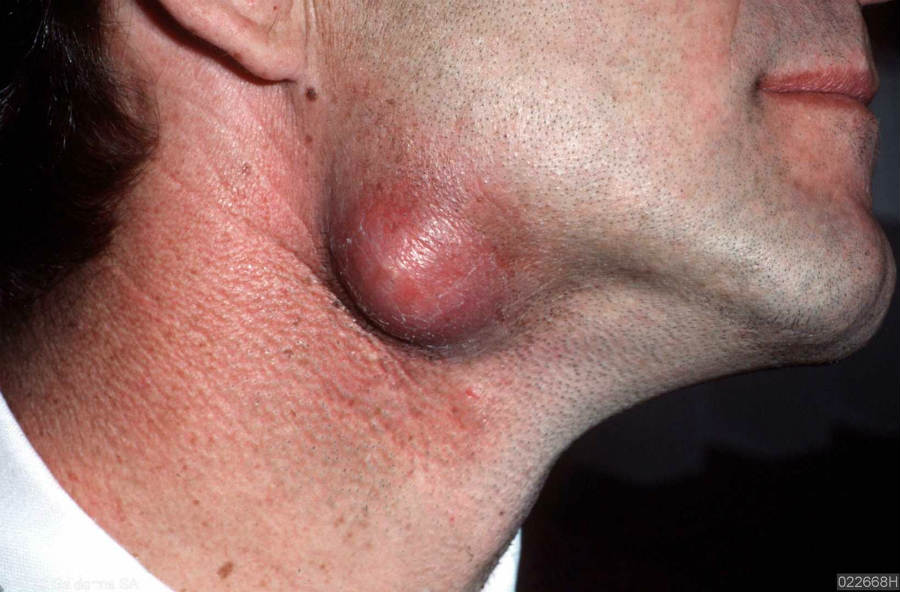 A cyst can get inflamed or infected from no obvious reason. An inflamed or infected cyst is usually tender or painful and covered with a red skin.
A cyst can get inflamed or infected from no obvious reason. An inflamed or infected cyst is usually tender or painful and covered with a red skin.
A doctors will usually leave an inflamed or infected cyst to heal for a weak before removing [4,5]. An inflamed cyst can be treated by an injection of the steroid triamcinolone [5], and an infected cyst by topical or oral antibiotics.
Picture 5. An infected sebaceous cyst below the jaw (source: Primary Care Dermatology Society, by permission)
Rupture
A big cyst, especially on the scalp, can burst on its own. Without prompt treatment, a ruptured cyst can get infected and can leave a wide irregular scar.
Cancer
Sebaceous [2], pilar [8] and epidermoid [7] cysts do not spread to other body locations and very rarely develop into skin cancers. Skin cancer can look as a bump with a red ulcer in the middle and usually appears on the sun-exposed skin on the face or neck.
Diagnosis
A primary doctor or a dermatologist can usually make a diagnosis of a sebaceous cyst by a simple inspection and without other investigations.
Differential Diagnosis
Lumps that can look similar as sebaceous, epidermoid or pilar cyst:
- Swollen lymph node (in the neck, armpits or groin)
- Lipoma
- Dermoid cyst
- Ganglion cyst (near the wrist or other joints; contains clear or yellow fluid)
- Digital mucous cyst (a small bump on a finger)
- Pilonidal cyst (in the tailbone area)
- Bartholin’s cyst in the vagina
- Skin cancer (basal or spinous cell carcinoma)
Treatment
Sometimes, a sebaceous cyst heals on its own.
Popping
If you pop a sebaceous cyst by yourself, it may get infected. A popped cyst usually returns within few months.
If a cyst starts to drain spontaneously, you can promote its draining by covering it by a warm moist cloth for 10-15 minutes several times a day.
Surgical Removal
A surgical excision of a sebaceous cyst starts with a thorough disinfection of the overlying skin and an injection of the local anesthetic. Surgical techniques include [5]:
1) The simplest technique involves an incision and drainage of the cyst without removing the cyst wall. After this procedure a cyst often recurs.
Video 1. Lancing, popping and drainage of a sebaceous cyst on the back
2) To completely remove small cysts, a doctor can use a minimal excision technique, which includes a short (2-3 mm) incision in the skin, squeezing the greasy material, curettage and removing the cyst wall by forceps. The surgical wound can heal without suturing and with a minimal scar.
3) Instead of a scalpel, a doctor can use laser to make a small hole in the skin and squeeze the greasy material from the cyst. A month later, a doctor removes the cyst wall [9].
4) To completely remove large cysts with their walls, a doctor will use conventional wide excision, which will leave a few centimeters long scar.
Video 2. Complete surgical excision of a sebaceous cyst under the jaw
Prevention
There is no known method of prevention sebaceous, epidermoid or pilar cysts [2]. Keeping acne under control can reduce the risk of developing the cysts, though [2].
Home Remedies
There seems to be no convincing evidence about the effectiveness of aloe vera, apple cider vinegar, bee pollen, castor oil, Epsom salt, tea tree oil, turmeric and other home remedies in the prevention or treatment of sebaceous cysts.
- References
- Morrell DS, Steatocystoma multiplex Emedicine
- Sebaceous Cysts Drugs.com
- Epidermal inclusion cyst, clinical presentation Emedicine
- Mukherjee S et al, 2015, Atypical sebaceous cyst: uncommon and unusual locations ResearchGate
- Zuber TJ et al, 2002, Minimal Excision Technique for Epidermoid (Sebaceous) Cysts American Family Physician
- Oakley A, Cutaneous cysts and pseudocysts DermNetNZ
- Fromm LJ, Epidermal inclusion cyst Emedicine
- Trichilemmal cyst (pilar cyst) treatment and management Emedicine
- Wu HuiLing et al, 20019, A New Procedure for Treating a Sebaceous Cyst: Removal of the Cyst Content with a Laser Punch and the Cyst Wall with a Minimal Postponed Excision PubMed Central
- Epidermoid cysts (sebaceous cysts) Mayo Clinic
- Anaya DA et al, 2008, Extracolonic Manifestations of Hereditary Colorectal Cancer Syndromes PubMed Central

